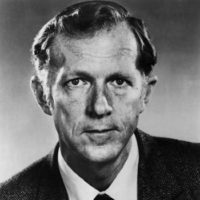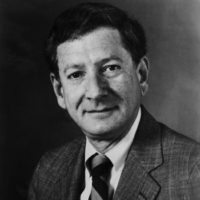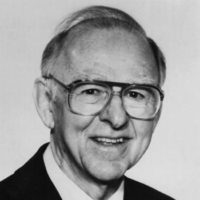
Michael J. Berridge
Trinity College

Alfred G. Gilman
UT Southwestern School of Medicine

Edwin G. Krebs
University of Washington School of Medicine

Yasutomi Nishizuka
Kobe University School of Medicine
For research revealing how IP3 governs the intracellular level of calcium and orchestrates the major activities of the cell.
Michael Berridge
In charting the path of a signal across the membrane of a cell, Dr. Berridge has discovered a biochemical pattern repeated throughout multicellular life, from microorganisms to human beings.
In 1969, while investigating the action of hormones on the secretory system of insects, Dr. Berridge discovered that calcium, an intracellular source of energy, is mobilized indirectly. He ascertained that an unknown molecule must be involved in carrying the signal from the receptor through the cell membrane and into the cell.
In a conceptually elegant and technically remarkable series of experiments, Dr. Berridge devised an assay for measuring the activity of hormone receptors. He measured the compounds created by the breakdown of a lipid within the membrane which was known to affect calcium concentration. Dr. Berridge discovered that lithium blocked the system, and used this finding to develop an exquisitely sensitive assay of receptor activity.
Dr. Berridge concluded that the second messenger which alters calcium level is one of the lipid's breakdown products, inositol trisphosphate (IP3). He thus discovered one of the essential signal pathways by which information is relayed from a hormone to its receptor, through a lipid in the cell membrane, and into the cell itself.
Intracellular calcium has biochemical effects of enormous consequence. The discovery of IP3 explains how the liver releases energy and how glands receive instructions to secrete specific products. It illuminates the processes of fertilization, and the growth and proliferation of cells. Dr. Berridge's research provides important insights into platelet aggregation and the formation of blood clots, as well as the metabolic defect underlying hypertension and the action of lithium in manic-depressive illness and depression.
To Dr. Michael Berridge, for his masterful research which has revealed how IP3 governs the intracellular level of calcium and orchestrates major activities of the cell, this 1989 Albert Lasker Basic Medical Research Award is given.
For the discovery that G-proteins carry signals that regulate vital processes within cells.
Alfred Gilman
In splendidly focused research, Dr. Gilman has shown how molecules within the cell membrane participate in conveying messages into the cell, in a process known as signal transduction. This series of biochemical steps begins when a hormone binds with its receptor molecule on the surface of a cell. It culminates with the synthesis of cyclic AMP, the molecular battery that energizes cellular processes.
In 1969, Dr. Gilman developed the first widely used assay for cyclic AMP. He then began to trace the events occurring within the cell membrane after a hormone binds to its receptor and before the appearance of cyclic AMP.
Dr. Gilman discovered that certain intercellular signals, including many hormones and neurotransmitters, depend upon proteins in the membrane to relay their instructions to the internal parts of the cell. Designated G-proteins in the cell membrane act as switches in controlling the traffic of transmembrane signaling. Each switch is turned on by the interaction of a receptor with a G-protein.
In addition to G-proteins which stimulate cellular processes, there are others of this family which are inhibitory. Still other G-proteins perform precise tasks within the membranes of specific types of cells: Some are involved in information processing in the brain and others in the photoreceptor cells that make vision possible.
These biochemical events enable specialized cells in organisms from yeasts to human beings to coordinate their specific cellular tasks.
To Dr. Alfred Gilman, for his pioneering studies of signal transduction and for his discovery that G-proteins carry signals that regulate vital processes within the cells, this 1989 Albert Lasker Basic Medical Research Award is given.
For the discovery of protein phosphorylation and the mechanistic understanding of protein kinase enzymes.
Edwin Krebs
In 1955, while studying the biochemistry of muscle cells, Dr. Krebs and his colleagues made the observation that the entire character of a protein can be changed by the addition of a single phosphate molecule, an event known as phosphorylation. He discovered an enzyme that adds phosphate to another enzyme, leading to the release of energy within the cell.
His discoveries, taken together, delineated for the first time a cascade of biochemical reactions which regulate cellular activity.
In a landmark article published in 1962, Dr. Krebs speculated that many different proteins, performing different tasks, might all be activated by the addition of phosphate. In this way, a host of cellular processes would all be switched on by phosphorylation.
Since then, Dr. Krebs, as well as other investigators around the world, have proven that protein phosphorylation governs an array of activities in cellular life. This process is central to the action of hormones, growth factors, and neurotransmitter molecules. Therefore, phosphorylation mediates cell growth, secretion, contraction, differentiation, and the biochemical mechanism of many carcinogens.
Dr. Krebs's prophetic vision of the role of protein phosphorylation opened the way to understanding the biochemistry that enables each cell to receive and respond to signals from other cells in the organism. This process, known as signal transduction, is essential to the evolution of multicellular organisms and is central to human life and health.
To Dr. Krebs, for his seminal finding that phosphorylation activates major enzymes in cells, and for perceiving the profound importance of protein kinase enzymes, this 1989 Albert Lasker Basic Medical Research Award is given.
For the discovery that carcinogens trigger cell growth by activating protein kinase C.
Yasutomi Nishizuka
In a scientific breakthrough of the first magnitude, Dr. Nishizuka discovered protein kinase C. This enzyme, found in the membrane of cells, is of overwhelming importance in the regulation of cellular life and, ultimately, in the maintenance of normal health in the individual.
Protein kinase C itself is regulated by calcium and by a specific lipid in the cell membrane. These interactions affect virtually every biochemical process in life, including secretion, metabolic responses, muscular contraction, and the growth and differentiation of cells. When the protein kinase C system is activated inappropriately, the result can be chaos within the cell, the disruption of biological patterns, and eventually disease or death.
Pursuing their studies of protein kinase C, Dr. Nishizuka and his group found that this enzyme can be activated by the experimental tumor-promoting agents known as phorbol esters. Phorbol esters remain bound in the cell membrane, provoking continuous protein kinase C activity and causing cells to grow and divide uncontrollably. This mechanism is the key to many types of carcinogenesis.
Dr. Nishizuka's monumental discovery has inspired a burst of research activity on protein kinase C and the various natural and environmental agents that act upon this pivotal enzyme. It is now recognized that protein kinase C and the processes that control this enzyme are absolutely necessary to all living things above the level of one-cell microorganisms.
To Dr. Yasutomi Nishizuka, for his profound contributions to the understanding of signal transduction in cells and for his discovery that carcinogens trigger cell growth by activating protein kinase C, this 1989 Albert Lasker Basic Medical Research Award is given.
